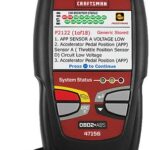Encountering an Obd2 Code P0118 can be concerning for any vehicle owner. This diagnostic trouble code signals a “Engine Coolant Temperature Sensor Circuit High” issue, indicating a potential problem within your car’s engine management system. As a crucial component for engine performance and longevity, the engine coolant temperature sensor requires immediate attention when this code arises. This article will delve into the intricacies of the P0118 code, exploring its meaning, causes, symptoms, and how to effectively diagnose and address it.
Decoding OBD2 Code P0118: Engine Coolant Temperature Sensor Circuit High
When your vehicle’s onboard diagnostic system registers a P0118 code, it means the Engine Control Module (ECM) has detected an abnormally high voltage signal from the Engine Coolant Temperature (ECT) sensor circuit. Essentially, the ECM perceives the coolant temperature as being excessively low, even when the engine should be warming up or at its normal operating temperature. This discrepancy triggers the P0118 code and often illuminates the check engine light on your dashboard, alerting you to a potential malfunction.
The ECT sensor plays a vital role in your engine’s operation. It continuously monitors the temperature of the engine coolant, providing real-time data to the ECM. This information is critical for the ECM to make precise adjustments to various engine parameters, including:
- Fuel Injection: Coolant temperature data helps the ECM determine the optimal air-fuel mixture. A cold engine requires a richer mixture for efficient combustion, while a warm engine needs a leaner mixture.
- Ignition Timing: The ECM adjusts ignition timing based on engine temperature to ensure optimal power and fuel efficiency.
- Thermostat Control: In some vehicles, the ECM can influence thermostat operation based on ECT sensor readings to maintain the ideal engine temperature range.
- Cooling Fan Operation: The ECM uses coolant temperature data to activate the engine cooling fans when necessary, preventing overheating.
Maintaining the correct engine operating temperature is paramount. An engine running too cold can suffer from reduced fuel economy, increased emissions due to incomplete combustion, and accelerated engine wear. Conversely, an engine running too hot can lead to serious damage, including overheating, cylinder head warping, and even engine failure. The P0118 code, therefore, indicates a problem that can disrupt this delicate thermal balance.
Unraveling the Causes of a P0118 Code
Several factors can lead to a P0118 code. Identifying the root cause is crucial for effective repair. Here are some common culprits:
- Faulty ECT Sensor: The sensor itself may be malfunctioning. Over time, ECT sensors can fail due to age, corrosion, or internal damage, leading to inaccurate readings and potentially a high voltage signal.
- Wiring and Connector Issues: Problems within the ECT sensor circuit’s wiring are frequent causes of P0118. This can include:
- Damaged Wiring: Wires can become frayed, cracked, or broken due to heat, vibration, or physical damage, interrupting the signal path.
- Corrosion: Corrosion on the wiring or connector terminals can increase resistance in the circuit, affecting signal voltage.
- Loose or Dirty Connectors: A loose or improperly connected sensor connector or ECM connector can disrupt the electrical connection, leading to signal issues.
- ECM Malfunction (Less Likely): While less common, a faulty Engine Control Module (ECM) can also trigger a P0118 code. If the ECM is misinterpreting signals or has internal issues, it might incorrectly register a high voltage from the ECT sensor circuit.
- Open Circuit in the Sensor Signal Wire: An open circuit, meaning a break in the electrical path, in the signal wire going to the ECT sensor can cause the ECM to read a high voltage.
It’s important to note that a low coolant level or a malfunctioning thermostat are less likely to directly cause a P0118 code. These issues typically lead to different codes related to engine overheating or cooling system performance. However, in some indirect scenarios, they might contribute to unusual temperature readings that could, in combination with other factors, trigger a P0118.
Recognizing the Symptoms Associated with P0118
While the presence of a check engine light is the most direct symptom of a P0118 code, you might also observe other signs indicating a problem with the ECT sensor circuit:
- Check Engine Light Illumination: This is the most immediate and noticeable symptom. The check engine light will illuminate on your dashboard to alert you to a detected issue.
- Poor Fuel Economy: If the ECM is receiving incorrect temperature data, it might enrich the fuel mixture excessively, leading to decreased fuel efficiency.
- Increased Emissions: An improperly controlled air-fuel mixture can result in higher levels of harmful emissions from your vehicle.
- Engine Running Rough or Hesitation: In some cases, an incorrect coolant temperature reading can cause the engine to run rough, particularly when cold, or exhibit hesitation during acceleration.
- Difficulty Starting (Especially in Cold Weather): The ECM relies on the ECT sensor to adjust fuel delivery during cold starts. A faulty sensor can make cold starts more challenging.
- Cooling Fan Running Continuously: In some situations, a P0118 code might cause the cooling fan to run constantly, even when the engine is cold, as the system might misinterpret the temperature reading.
- Engine Overheating (Less Common, but Possible): Although P0118 usually indicates a “high circuit” (low temperature reading), in some complex scenarios, a faulty sensor or circuit issue could indirectly contribute to or mask an overheating condition. This is less typical for P0118 directly but worth noting.
It’s important to address a P0118 code promptly, even if the symptoms seem mild. Ignoring this code can lead to more significant engine performance issues and potential long-term damage.
Diagnosing the P0118 Code: A Step-by-Step Approach
Diagnosing a P0118 code requires a systematic approach to pinpoint the exact cause. A qualified technician will typically follow these steps:
- Initial Scan and Verification: The diagnosis begins with connecting an OBD2 scan tool to the vehicle’s diagnostic port. This confirms the presence of the P0118 code and checks for any other related trouble codes that might provide additional clues.
- Visual Inspection: A thorough visual inspection of the ECT sensor, its wiring, and connectors is crucial. The technician will look for:
- Damaged or frayed wiring.
- Corrosion on connectors.
- Loose or improperly connected sensor or ECM connectors.
- Any signs of physical damage to the sensor itself.
- Live Data Analysis: Using the scan tool, the technician will access live data from the ECT sensor. This allows monitoring the sensor’s readings in real-time as the engine warms up. They will check if the temperature readings are plausible and consistent with the actual engine temperature. An abnormally low or erratic reading when the engine is warm would indicate a sensor or circuit problem.
- Sensor Circuit Testing: A multimeter is used to test the ECT sensor circuit for:
- Continuity: Checking for breaks or open circuits in the wiring between the sensor and the ECM.
- Voltage: Verifying that the sensor is receiving the correct reference voltage from the ECM.
- Ground: Ensuring proper ground connection for the sensor circuit.
- Sensor Resistance: Measuring the sensor’s resistance and comparing it to manufacturer specifications. A faulty sensor will often exhibit incorrect resistance values.
- Component Testing (ECT Sensor): The ECT sensor itself can be tested directly. This might involve:
- Resistance Test at Different Temperatures: Immersing the sensor in water at different temperatures and measuring its resistance to see if it changes as expected according to the manufacturer’s specifications.
- Sensor Signal Output Test: Using specialized tools to simulate engine operation and directly measure the sensor’s voltage output.
- ECM Inspection (If Necessary): If all wiring and sensor tests are inconclusive, and all other possibilities are ruled out, the ECM itself might be suspected. However, ECM issues are less common. Testing the ECM usually involves specialized equipment and is typically performed as a last resort.
By following these diagnostic steps, a technician can accurately identify whether the issue lies with the ECT sensor, the wiring, the connectors, or, in rare cases, the ECM.
Severity and Addressing P0118: Prompt Action is Key
The severity of a P0118 code can range from moderate to potentially serious if left unaddressed. While in some cases, you might not immediately notice significant drivability issues, driving with a P0118 code for an extended period is not recommended.
Potential Consequences of Ignoring P0118:
- Reduced Fuel Efficiency: Incorrect fuel mixture adjustments due to faulty temperature readings can lead to wasted fuel and increased running costs.
- Increased Emissions and Failed Emissions Test: Higher emissions can result in failing emissions tests, which are required in many regions.
- Engine Damage Over Time: While less immediate, prolonged operation with incorrect temperature readings can contribute to long-term engine wear and tear.
- Rough Engine Performance and Driveability Issues: As mentioned earlier, you may experience rough idling, hesitation, and difficulty starting, especially in cold weather.
- Potential for Failsafe Mode: In some vehicles, the ECM might enter a failsafe or “limp mode” when a P0118 code is present. This mode restricts engine performance to protect it from potential damage, which can significantly impact driving experience.
Recommended Action:
It’s advisable to have a P0118 code diagnosed and repaired as soon as possible, ideally within a week or so of it appearing. Prompt attention will help prevent potential drivability problems, ensure optimal fuel economy, and avoid potential long-term engine issues.
Resolving P0118: Common Repair Solutions
The repair for a P0118 code depends entirely on the underlying cause identified during diagnosis. Common solutions include:
- ECT Sensor Replacement: If the sensor is found to be faulty, replacing it with a new, high-quality sensor is usually the solution.
- Wiring Repair: If damaged wiring is the culprit, repairing or replacing the affected sections of wiring in the ECT sensor circuit is necessary. This might involve splicing wires, replacing connectors, or repairing chafed insulation.
- Connector Cleaning or Replacement: Corroded or damaged connectors should be cleaned or replaced to ensure a good electrical connection.
- ECM Repair or Replacement (Rare): In the rare case of a faulty ECM, repair or replacement of the ECM may be required. ECM replacement is a more complex and costly procedure that should only be considered after thorough diagnosis.
After the necessary repairs are completed, the technician will clear the P0118 code using a scan tool and often perform a test drive to ensure the issue is resolved and the check engine light does not reappear.
Related Diagnostic Trouble Codes
Understanding related diagnostic trouble codes can sometimes provide additional context. Codes related to the Engine Coolant Temperature Sensor circuit include:
- P0115: Engine Coolant Temperature Sensor Circuit Malfunction: This is a more general code indicating a malfunction within the ECT sensor circuit.
- P0116: Engine Coolant Temperature Sensor 1 Circuit Range/Performance: This code suggests that the ECT sensor signal is within range but not performing as expected, possibly indicating a sensor that is slow to respond or providing inaccurate readings within its range.
- P0117: Engine Coolant Temperature Sensor Circuit Low: This code is the opposite of P0118, indicating that the ECM is detecting an abnormally low voltage signal from the ECT sensor circuit, suggesting a high temperature reading (potentially a short to ground).
By understanding the nuances of OBD2 code P0118 and its related codes, car owners can be better informed about potential engine coolant temperature sensor circuit issues and take timely action to maintain their vehicle’s health and performance.

